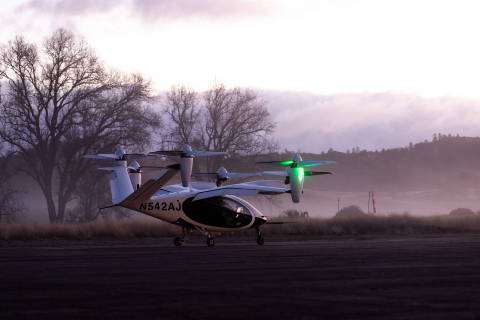Joby and NASA Collaborate to Measure Noise Footprint of Electric Air Taxi
-
Joby becomes first company to fly an electric aircraft as part of NASA’s Advanced Air Mobility National Campaign
-
Two-week test campaign will analyze the noise footprint of Joby’s aircraft
- Builds on almost a decade of joint research by Joby and NASA into electric flight

The Joby aircraft (Photo: Business Wire)
NASA’s AAM National Campaign is designed to promote public confidence in emerging aviation markets, such as passenger air taxis, through flight testing in realistic scenarios and data analysis that will inform the development of regulatory standards for emerging aviation platforms.
As part of the two-week test campaign at Joby’s Electric
"NASA is proud to continue our relationship with Joby by gathering highly valuable aircraft safety and noise data that will contribute towards an aviation future that includes Advanced Air Mobility (AAM) operations," said
NASA engineers will deploy their Mobile Acoustics Facility and more than 50 pressure ground-plate microphones in a grid array that allows for multi-directional measurement of the Joby aircraft’s sound emissions. Using this data, NASA and Joby will generate noise hemispheres for the aircraft that capture the intensity and the character of the sound emitted in comparison to helicopters, drones, and other aircraft.
These readings, in combination with the noise profile of urban communities, can be used to verify how proposed aircraft operations will blend into the existing background noise. Joby has released several videos showcasing the quiet nature of the company’s aircraft during take-off, hover, and overhead flight.
“NASA has been a critical catalyst in the transition to electric aviation, and we’re proud to have partnered with them on multiple groundbreaking projects since our first collaboration in 2012,” said
“From day one, we prioritized building an aircraft that not only has an extremely low noise profile, but blends seamlessly into the natural environment. We have always believed that a minimal acoustic footprint is key to making aviation a convenient part of everyday movement without compromising quality of life, and we’re excited to fly with NASA, our long-time partners in electric flight, to demonstrate the acoustic profile of our aircraft.”
Joby’s participation in the National Campaign marks the next step in a long history of collaboration between the two parties. Over the last decade, Joby has worked with NASA on a range of aircraft projects that have explored electric propulsion, including a long-endurance eVTOL demonstrator called Lotus, the Leading Edge Asynchronous Propeller Technology (LEAPTech) project, and the design of the X-57 Maxwell experimental aircraft now undergoing systems integration testing.
With a maximum range of 150 miles recently demonstrated during flight testing, and a top speed of 200 mph, Joby’s aircraft is designed to carry four passengers and a pilot with zero operating emissions. With more than 1,000 flight tests completed and full-scale prototypes in the air since 2017,
The aircraft is powered by six propellers that tilt to enable vertical takeoff and efficient cruise flight. The number of blades, blade radius, tip speeds, and disk loading of the aircraft were all selected to minimize the acoustic footprint and improve the character of the noise produced. The propellers can also individually adjust their tilt, rotational speed, and blade pitch, helping to avoid the blade vortex interactions that cause the “wop wop” sound we associate with traditional helicopters.
Once testing is complete, a team of acoustic experts from NASA and Joby will work together to analyze the data before sharing their findings later in the year.
A blog post detailing the history of Joby’s partnership with NASA was previously published on Joby’s company website.
Joby recently listed on the
ABOUT
Forward Looking Statements
This press release contains “forward-looking statements” within the meaning of the “safe harbor” provisions of the Private Securities Litigation Reform Act of 1995, including but not limited to, statements regarding the planned campaign with NASA, development of Joby’s aircraft and financial and market outlook. Forward-looking statements give Joby’s current expectations and projections relating to our financial condition, results of operations, plans, objectives, future performance and business. You can identify forward-looking statements by the fact that they do not relate strictly to historical or current facts. These statements may include words such as “anticipate”, “estimate”, “expect”, “project”, “plan”, “intend”, “believe”, “may”, “will”, “should”, “can have”, “likely” and other words and terms of similar meaning in connection with any discussion of the timing or nature of future operating or financial performance or other events. All forward-looking statements are subject to risks and uncertainties that may cause actual results to differ materially from those that we expected, including: Joby’s limited operating history and history of losses; its ability to launch its aerial ridesharing service and the growth of the urban air mobility market generally; Joby’s plans to operate a commercial passenger service beginning in 2024; the competitive environment in which it operates; its future capital needs; its ability to adequately protect and enforce its intellectual property rights; its ability to effectively respond to evolving regulations and standards relating to its aircraft; its reliance on a third-party suppliers and service partners; uncertainties related to Joby’s estimates of the size of the market for its aircraft and future revenue opportunities; and other important factors discussed in the Company’s final prospectus and definitive proxy statement, dated
View source version on businesswire.com: https://www.businesswire.com/news/home/20210901005334/en/
Investors: investors@jobyaviation.com
+1-831-201-6006
Media:
Joby: press@jobyaviation.com
+1-408-489-4015
Source:







